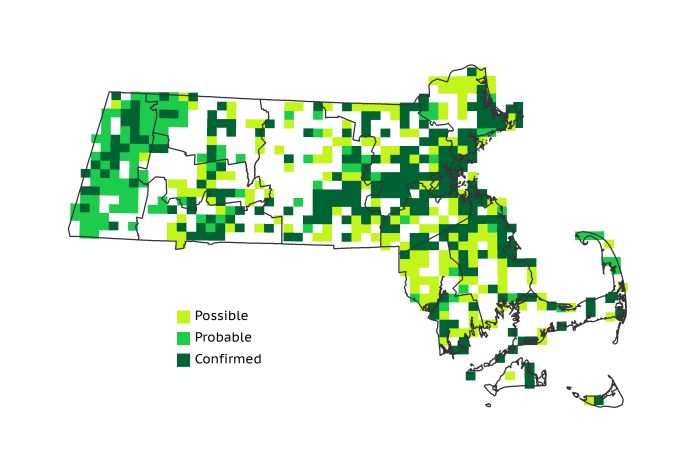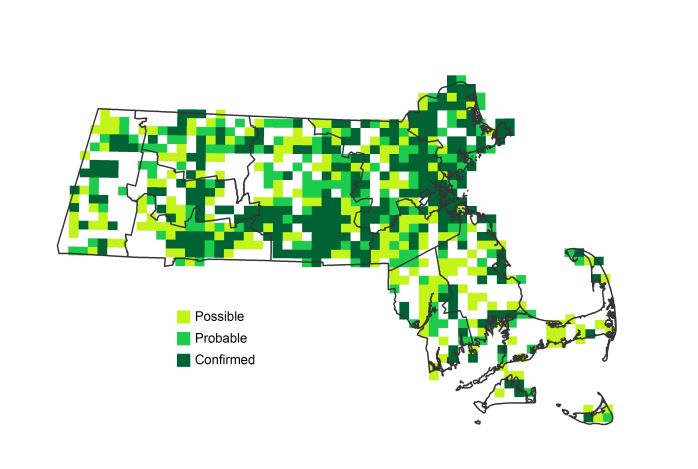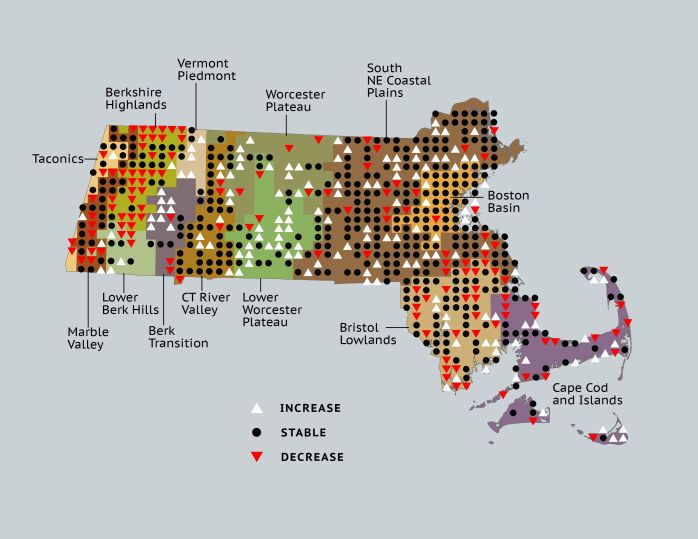Breeding Bird Atlases (BBA)
Find a Bird
Rock Pigeon
Columba livia

Widespread and stable
“If pigeons had teeth / Children in the park / Would be less likely to aggravate them” – Dicky Cantrell, “If Pigeons Had Teeth”
Rock Pigeons have served the human race as messengers, as a source of food, as human companions, and as test subjects for innumerable scientific experiments. Their direct contributions to the fields of war, psychology, navigation, genetics, and evolutionary theory likely exceed those of any other avian species. Such a profoundly useful bird made it a logical choice for European settlers to bring to the New World during the early Colonial period. Rock Pigeons eventually became successfully established and are now found living alongside humans throughout the Commonwealth and beyond, though they are rarely encountered away from human influence.
Historic Status
Historical ornithological studies of the species known to frequent Massachusetts are replete with tales of Passenger Pigeons and Mourning Doves, but leave a gap where the story of the Rock Pigeon, or Rock Dove, should be told. The birds arrived from Europe as domesticated species in the New World during the period between 1603 and 1607 (Schorger 1952). Once they escaped, they became feral and expanded their population. As cities grew, pigeons took to them readily. “In the stone, brick and concrete buildings of New England cities,” wrote Edward Howe Forbush in 1927, “the doves find sheltered recesses such as occur in the native cliffs of their wild progenitors, and here they build their nests, high up on ledges, under windows, verandas, or porticos, under bridges or wherever they can find reasonable safety.”
Atlas 1 Distribution
Rock Pigeons could be found in all corners of the Commonwealth in Atlas 1. The network of urban and agricultural areas in the Marble Valleys, from Adams through Pittsfield and south to Sheffield, had plenty of breeding pigeons. The species was also curiously widespread in the much less densely developed Berkshire Highlands, though it found the less-settled Vermont Piedmont and Berkshire Transition regions not as hospitable. Pigeons had a considerable presence in the Connecticut River Valley, where people and food were abundant, as well as in the Lower Worcester Plateau around the city of Worcester itself. Otherwise, the forested center of the state had relatively few pigeons. Naturally, the metro Boston areas of the Coastal Plains and Boston Basin were rife with breeding pigeons, and New Bedford and Fall River both attracted pigeons to the Bristol/Narragansett Lowlands. Pigeon distribution was less concentrated on the Cape and Islands, though the birds were nonetheless recorded fairly often.
Atlas 2 Distribution and Change
In the three decades between the Massachusetts breeding bird atlases, Rock Pigeons went on a wild ride. They markedly declined in Breeding Bird Survey studies, but were found nesting in slightly more of the state in Atlas 2 than they were in Atlas 1. This may have had something to do with field recording in Atlas 1 – at that time many people simply failed to record Rock Pigeons as “wild” birds, they were excluded from many Christmas Bird Counts, and they were probably excluded from many Atlas 1 field cards as well. This makes understanding their increases more difficult, although several trends do emerge when we evaluate their losses. As if by magic, they disappeared wholesale from the Berkshire Highlands, vanishing from more than 50% of the blocks they previously inhabited. They also retreated from the Bristol/Narragansett Lowlands, but made gains on the Worcester Plateau regions and on the Coastal Plains.
Atlas 1 Map

Atlas 2 Map

Atlas Change Map

Ecoregion Data
Atlas 1 | Atlas 2 | Change | ||||||
Ecoregion | # Blocks | % Blocks | % of Range | # Blocks | % Blocks | % of Range | Change in # Blocks | Change in % Blocks |
Taconic Mountains | 10 | 62.5 | 1.8 | 9 | 36.0 | 1.4 | -2 | -13.3 |
Marble Valleys/Housatonic Valley | 36 | 92.3 | 6.4 | 29 | 74.4 | 4.5 | -7 | -17.9 |
Berkshire Highlands | 45 | 81.8 | 8.0 | 17 | 30.9 | 2.6 | -28 | -52.8 |
Lower Berkshire Hills | 11 | 39.3 | 1.9 | 9 | 29.0 | 1.4 | -2 | -7.4 |
Vermont Piedmont | 4 | 23.5 | 0.7 | 13 | 76.5 | 2.0 | 5 | 41.7 |
Berkshire Transition | 10 | 26.3 | 1.8 | 21 | 52.5 | 3.2 | 6 | 19.4 |
Connecticut River Valley | 45 | 80.4 | 8.0 | 56 | 86.2 | 8.6 | 4 | 8.3 |
Worcester Plateau | 21 | 26.9 | 3.7 | 46 | 52.3 | 7.1 | 10 | 20.8 |
Lower Worcester Plateau | 24 | 32.4 | 4.2 | 47 | 58.8 | 7.3 | 16 | 29.6 |
S. New England Coastal Plains and Hills | 188 | 69.6 | 33.3 | 229 | 80.9 | 35.3 | 21 | 9.3 |
Boston Basin | 48 | 85.7 | 8.5 | 54 | 96.4 | 8.3 | 6 | 10.9 |
Bristol and Narragansett Lowlands | 74 | 69.8 | 13.1 | 64 | 56.1 | 9.9 | -11 | -10.9 |
Cape Cod and Islands | 49 | 36.0 | 8.7 | 54 | 37.5 | 8.3 | 0 | 0.0 |
Statewide Total | 565 | 58.3 | 100.0 | 648 | 62.5 | 100.0 | 18 | 2.2 |
Notes
Breeding Bird Survey (BBS) data indicate a decline in abundance for this species, and it is likely that Atlas 2 overestimated their increase. The Rock Pigeon shows significant decreasing BBS trends in Massachusetts, the Mid-Atlantic/New England region, and the whole Eastern US.



